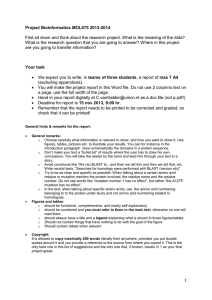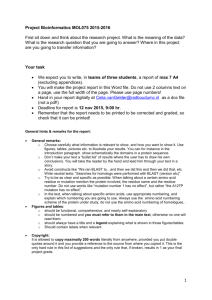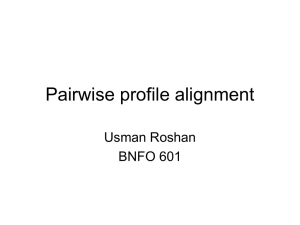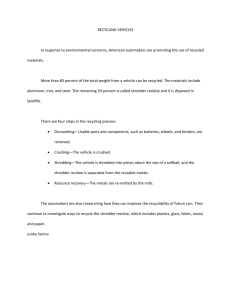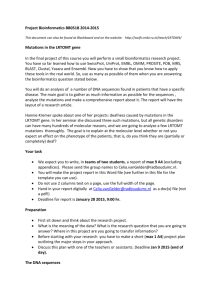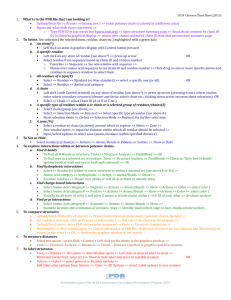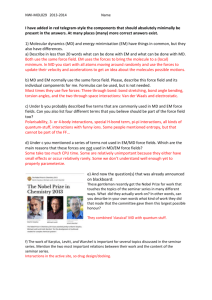Template for report
advertisement
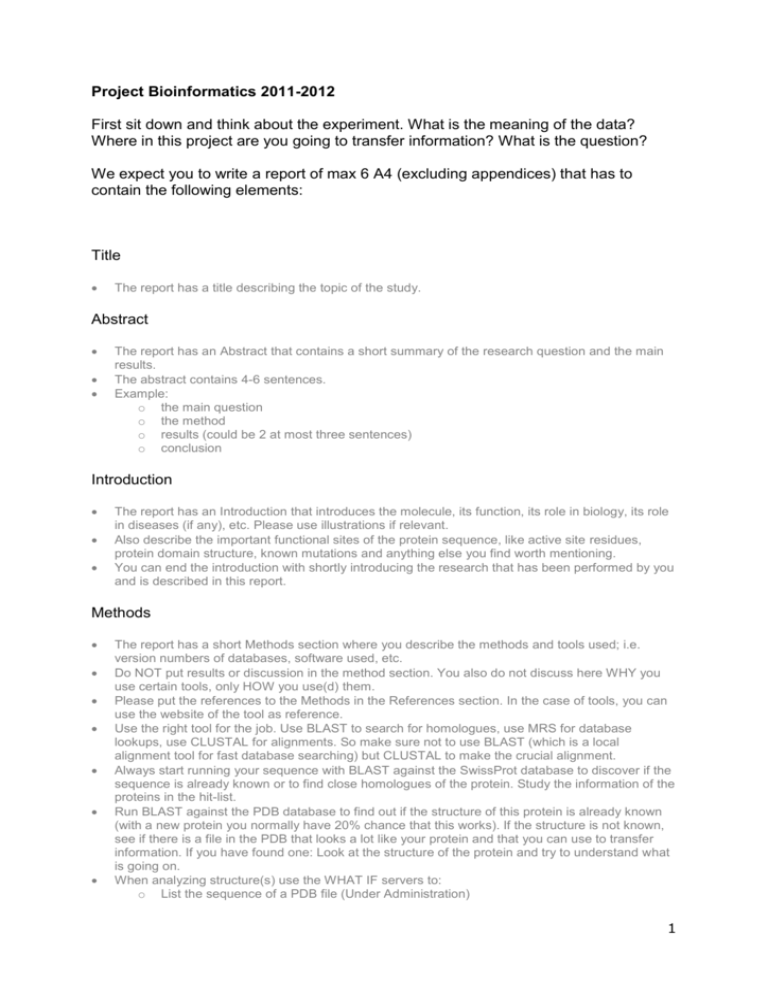
Project Bioinformatics 2011-2012 First sit down and think about the experiment. What is the meaning of the data? Where in this project are you going to transfer information? What is the question? We expect you to write a report of max 6 A4 (excluding appendices) that has to contain the following elements: Title The report has a title describing the topic of the study. Abstract The report has an Abstract that contains a short summary of the research question and the main results. The abstract contains 4-6 sentences. Example: o the main question o the method o results (could be 2 at most three sentences) o conclusion Introduction The report has an Introduction that introduces the molecule, its function, its role in biology, its role in diseases (if any), etc. Please use illustrations if relevant. Also describe the important functional sites of the protein sequence, like active site residues, protein domain structure, known mutations and anything else you find worth mentioning. You can end the introduction with shortly introducing the research that has been performed by you and is described in this report. Methods The report has a short Methods section where you describe the methods and tools used; i.e. version numbers of databases, software used, etc. Do NOT put results or discussion in the method section. You also do not discuss here WHY you use certain tools, only HOW you use(d) them. Please put the references to the Methods in the References section. In the case of tools, you can use the website of the tool as reference. Use the right tool for the job. Use BLAST to search for homologues, use MRS for database lookups, use CLUSTAL for alignments. So make sure not to use BLAST (which is a local alignment tool for fast database searching) but CLUSTAL to make the crucial alignment. Always start running your sequence with BLAST against the SwissProt database to discover if the sequence is already known or to find close homologues of the protein. Study the information of the proteins in the hit-list. Run BLAST against the PDB database to find out if the structure of this protein is already known (with a new protein you normally have 20% chance that this works). If the structure is not known, see if there is a file in the PDB that looks a lot like your protein and that you can use to transfer information. If you have found one: Look at the structure of the protein and try to understand what is going on. When analyzing structure(s) use the WHAT IF servers to: o List the sequence of a PDB file (Under Administration) 1 o o Analyze protein-cofactor contacts (Under Protein Analysis) Analyze hydrogen bonds Results & Discussion In these sections the results of your study have to be described, including an explanation of the strategy you used, the steps you took, etc. They also include the final results, i.e. the answers to the biological question(s). Think about the layout of the text, if possible start new paragraphs with a (meaningful) title. You should also discusses shortly potential weaknesses in your study, suggestions for follow-up research and anything else you think should be discussed. A research report about transfer of information is not complete without showing the crucial alignment in the main text (so not in the Appendix). A very common problem is the residue numbering problem. Please get your sequences and numbering scheme straight. One way to achieve this is to make a sequence alignment of the relevant sequences and indicate the residue numbers in the sequences. Normally, we call residue the N-terminal residue in the full-length wild-type protein residue number 1. All other numbers can be related to that. Conclusion A short Conclusion section at the end of the main text, containing overall conclusion of your research. Acknowledgements If you want you can add Acknowledgements. References A list of references. Make sure that you quote the references in the text of the report. Choose one method of referencing and use this method for all references. Appendices Feel free to use Appendices but choose carefully what to put in the main text, what to put in an Appendix, and what not to put in at all because you can also describe it in two sentences instead of showing a large computer output. Appendices contain additional information that is not required to follow the flow of the story you tell in the report. If you use Appendices make sure to refer to it in the main text, otherwise they will not be read at all. 2 General hints & remarks for the report: Try to be as clear and specific as possible. When talking about a certain amino acid residue mention the protein involved, the residue name and the residue number. Make sure any figures and tables are functional, comprehensive, and nearly self-explanatory. Figures and tables should be numbered and you must refer to them in the main text. Figures and tables should always have a title and a legend explaining what is shown in those figures/tables. Choose carefully what is relevant to show and how you want to show it. Use figures, tables, pictures etc. to illustrate your results. Examples: o Try to remove that extra molecule in the background. o Try to remove hydrogens if showing them is not relevant. o Only label atoms or residues that you discuss in the text. o Use colours only when needed to show something or to help the reader find a residue, atom, interaction, etc., and not because they make the picture nicer. o Think of ways to illustrate important amino acids in your alignment. Use colours, numbers, boxes, labels etc. o Skip useless data. If an alignment has been made to only find out if two sequences are homologs, then you should not put the alignment in the report. But if an alignment was made to transfer information from one sequence to another, an alignment is needed. It is allowed to copy maximally 200 words literally from anywhere, provided you put double quotes around it and you provide a reference to the source from where you copied it. This is the only hard rule in this list of suggestions and the only rule that, if broken, results in 1 as your final grade. 3
